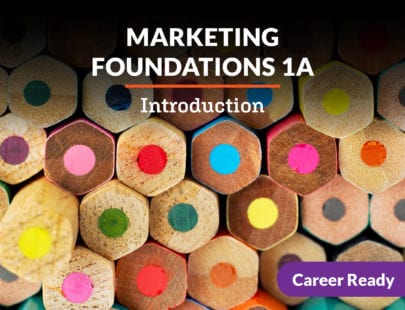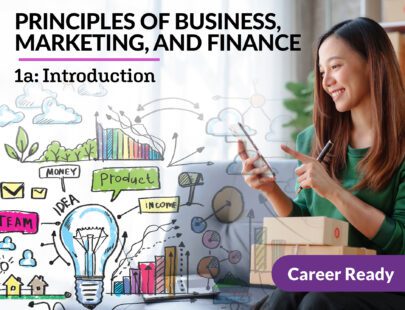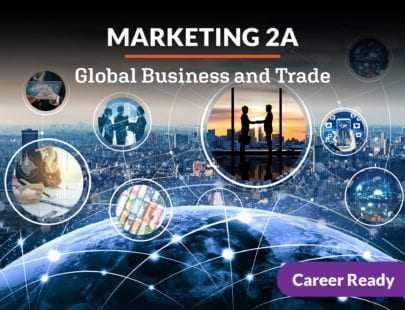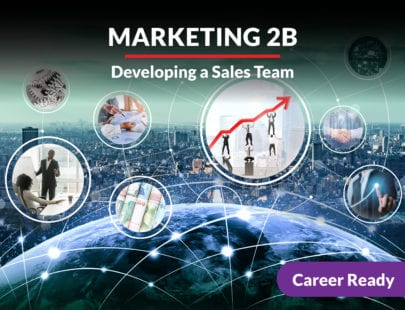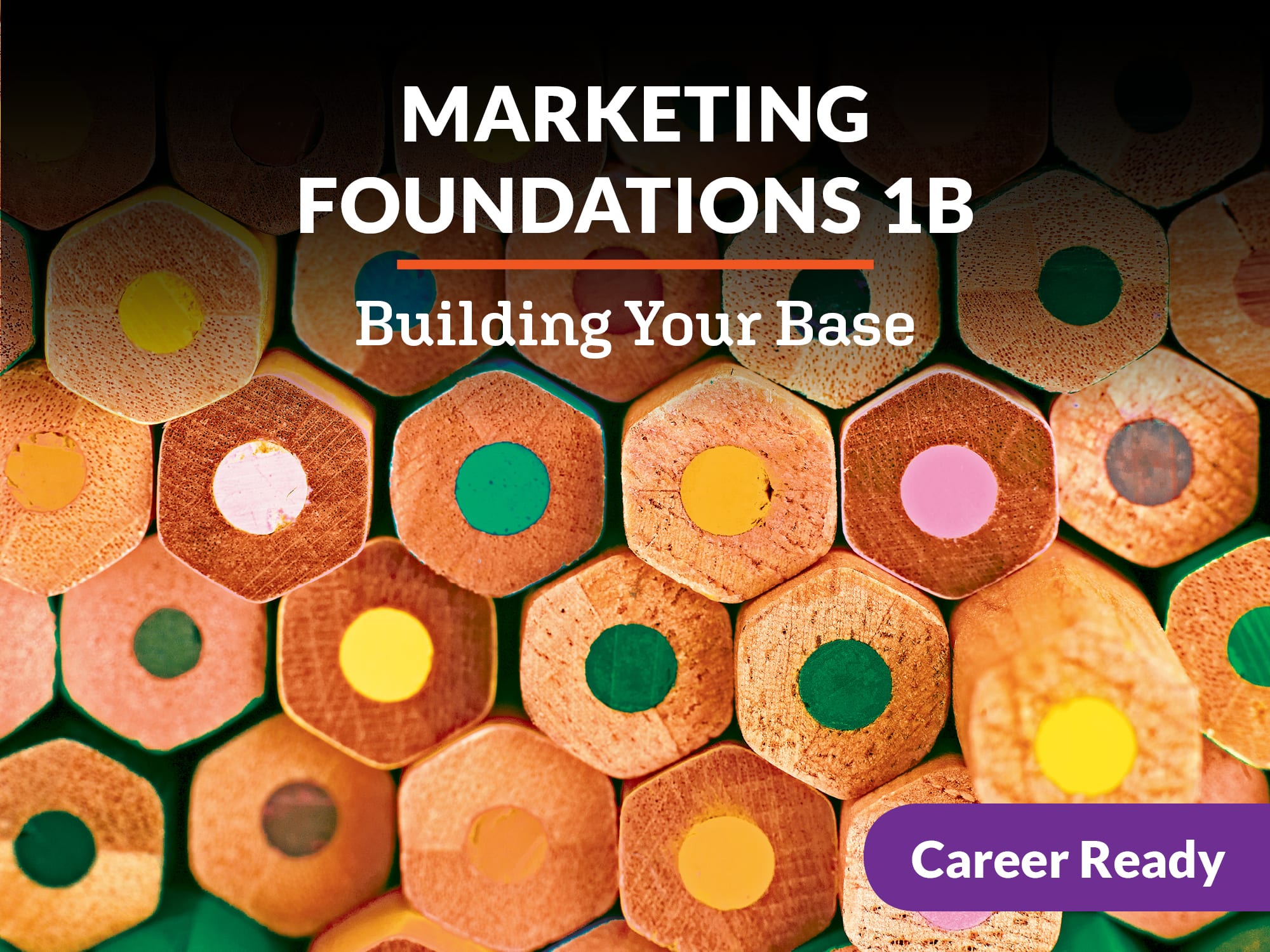
Marketing Foundations 1b: Building Your Base
Dig deeper into the world of marketing and what it means for business success! Become a marketing mix pro by studying understanding branding, advertising, promotion strategies, and more, through real-world applications and practices. And explore the secrets of advertising and promotion. Learn about effective sales techniques and discover employment opportunities to pursue a career in this exciting field!
Units at a Glance
Unit 1: Product and Service Development and Planning
Finishing a marathon in less than two hours? It’s never been done. In fact, it’s humanly impossible, right? Well, in 2017, Nike brazenly challenged this idea with a bold new marketing campaign for a cutting-edge product: Vaporfly Elite sneakers. The company launched the “Breaking2” project and shocked everyone by partnering with National Geographic to document it. A feature-length video resulted that chronicled the training of three of the world’s top marathon runners as they prepared for this very special live-streamed event. The result? Eliud Kipchoge came the closest but missed 1:59:59 by 26 seconds. Even though Breaking2 was technically a failure, the campaign itself was a huge win for Nike. The novel approaches they took to planning, developing, and marketing their product ended up capturing the hearts and minds of athletic fans all around the world. But how did Nike know which direction to take for these sneakers? Learn the secrets of their success—and more! On your mark… Get set… Let’s go!
What will you learn in this unit?
- Examine how businesses determine products/services to produce and sell
- Identify key product-mix strategies and explain the significance of brands in product planning
- Demonstrate an understanding of the importance of ensuring quality of products and services
- Identify stages of the product life cycle
Unit 2: Place, Storage, and Organization of Distribution Channels
Have you ever seen Amazon’s offers for same-day delivery? Same day? How is that even possible? The secret lies in their phenomenally advanced fulfillment networks which set them (very far) apart from their competitors. They even have 100,000 robots working in their warehouses! While Amazon is clearly in a league of its own, other retailers are busy shipping their packages, too. Whether by train, plane, automobile, or good old-fashioned storefront, products and services are being made available to customers in global markets that were previously unreachable. Now it’s time for us to start our engines and explore how distribution channels have changed the ways that people do business—and see what the future holds for the next generation of shoppers!
What will you learn in this unit?
- Explain the nature of channels of distribution
- Explore the functions of the shipping and receiving process in the success of the distribution function
- Analyze how distribution affects the cost of products
- Recognize the logistics of product delivery and importing and exporting products and services
Unit 3: Promotion and Advertising
Have you ever heard of Rob Shoesmith? This sanitation worker-turned-blogger holds a record for the longest wait-in-line for a new iPhone. Would you believe that he camped out at an Apple Store for 10 days to get his hands on one!? What compels people to go to extremes to be among the first to own that new… “fill-in-the-blank”? Two things: promotion and advertising. They’re the reason customers become convinced that the purchase of a new product is their most immediate and biggest priority. Promotion and advertising also determine how effective a company’s marketing will be. If there’s anything you need to master before you can call yourself an expert marketer, it’s definitely those two things. They will help you understand all the strategies businesses use to attract customers and give you the edge you need to be a serious player in the marketing game.
What will you learn in this unit?
- Define promotional mix and promotional mix strategies
- Analyze how creativity, compelling communication, design, positioning, and target marketing effectively reach customers
- Differentiate between publicity, public relations, and advertising
- Identify and explain differences between indirect and direct marketing
Unit 4: The Art of the Sale
Have you ever mentioned something completely obscure to someone and ads pop up about it on your feed a day or two later? Is it a coincidence? Well other than “It’s very, very unlikely,” as one former Facebook operations manager put it, there doesn’t seem to be a straightforward explanation. With artificially-intelligent virtual assistants being built into televisions, phones, speakers, security systems, and even cars, it really makes you think about how often you’re being monitored by your devices. Alexa and Google Assistant can recognize your voice and tailor shopping and music results to your tastes, but just how much further will companies go to get their products in front of you? And what, exactly, do they know about you already? One thing’s for sure—artificial intelligence is radically changing the ways that products and services are being sold. And it’s possible that new tech is being tried out on you right now to make it better and better! So, level the playing field and empower yourself as both a seller and a consumer. It starts…right…now.
What will you learn in this unit?
- Explain the influence customers have over the ways products or services are marketed and sold
- Examine client lists and the significance of keeping accurate client records
- Identify stages of the product life cycle
- Assess how technology is used in the selling of products and services
Unit 5: Pricing in the Marketing Mix
Everybody loves a bargain, right? Saving money on products and services can be a real thrill! But would you believe that it can be just as thrilling to pay extra for an item!? It all has to do with what you actually get for the money. Take TOMS shoes, for example. When founder Blake Mycoskie traveled to Argentina and saw children so impoverished that they didn’t have shoes, he vowed to take action. Mycoskie went back to the United States and created simple, unassuming pairs of shoes that he put up for sale—each with a promise: “You buy a pair, we give a pair.” Word of this philanthropy spread quickly. People were eager to shell out $60 for a pair of plain, cloth shoes because it made them feel charitable. To date, TOMS has donated more than 86 million pairs of new shoes to children in need. They’ve expanded their “One for One” commitment to now include coffee, eyeglasses, water, bullying prevention, and safe births for babies. With a reputation for being one of the most ethical businesses around, TOMS teaches us a valuable lesson: you can’t put a price on the feeling you get from “doing good,” and as you’ll see, there’s more than meets the eye when it comes to pricing!
What will you learn in this unit?
- Understand how businesses determine their pricing strategy
- Learn the various inputs and types of pricing
- Explain the importance of ensuring quality of products and services
- Identify stages of the product life cycle
Unit 6: Technology and Safety Management in Business Today
Technology has affected marketing in the most incredible ways! First of all, finding customers is so much easier than it was in the past. Site visitors often voluntarily leave their email addresses and sign up for notifications. There are also lead generation services that can provide contact information for groups of people like VPs of sales or purchasers. Customization has also improved, making it possible to change the images a visitor sees on a website based upon their personal preferences. These ads are targeted to fit the psychological profile of each shopper, and it makes for a very personalized experience. Finally, the data provided to marketers is richer than it has ever been. They can see how much time was spent on each web page and how the visitors interacted with those pages. Amazingly, there can also be a projected value associated with each customer to help determine how aggressively a company should pursue them! With all this data available, companies can spend more time identifying their target audience, which leads directly to sales, instead of merely gathering their information. Let’s learn some more tricks of the trade so that you can compete at the highest level in marketing!
What will you learn in this unit?
- Explain the importance of technology in marketing
- Describe the components of a marketing information system
- Explore job safety issues
- Examine e-commerce and the role it plays in 21st-century marketing
Unit 7: Entrepreneurship and Human Relations
Bet you’ve heard of fidget spinners! They’ve only been on the market since 2016, but these little gadgets caught on and spread like wildfire! Would you believe that they were created by two 17-year-olds who were having a difficult time sitting still in class? Allan Maman and Cooper Weiss used their school’s 3-D printer to fill the need, and in just six months, they brought in hundreds of thousands of dollars in sales—enough to buy eight more printers and relocate the business to Weiss’s basement. They quickly outgrew that and had to set up a factory with 30 printers that churned out spinners all day and night. Reaching their max at the factory, they switched over to injection molding and outsourced to China. Of course, it wasn’t long before knock-offs started appearing on the shelves. And though imitation is the best source of flattery, it can also gouge profits. Not to be outdone by copycats, the two entrepreneurs created shell companies to sell cheap versions of their own products—how’s that for ingenuity!? Ready to find out what it takes to be an entrepreneur? Let’s go!
What will you learn in this unit?
- Identify what an entrepreneur is and explain what they do
- Expound upon the interpersonal skills required to run a business
- Describe best practices for maintaining a cohesive team
- Learn which values create strong and respectful companies
Unit 8: Employability Skills Necessary for a Career in the Marketing World
From the outside looking in, marketing might seem like a complicated career to get into. But thanks to the internet and Twitter, you have access to the most cutting-edge thoughts about marketing from the most influential marketers in the world. People like Ann Handley, who tweets her fresh take and new approaches to marketing, and Chris Brogan, who has worked with Google, Disney, and Coca-Cola—they’re all right at your fingertips! You might imagine that you need to be some sort of creative genius to come up with ideas for marketing campaigns or sales presentations, but there’s so much inspiration available to you that the advantage is totally in your favor. Let’s dive into the nuts and bolts of a career in marketing. Then we’ll discover and leverage your strengths to find the niche that suits you best. You can do this!
What will you learn in this unit?
- Research strategies for a career in marketing
- Explore employment opportunities in marketing
- Create a career plan
- Examine hard and soft skills needed for success in a business career
Required Materials
Computer with:
-
- Internet access
- Word processing program
- Slideshow presentation program
- Camera for still photographs (either digital or cell phone camera)
- Video recording device with audio (computer camera, cell phone camera, etc.)
- Audio recording device for podcast recording
- Access to television, magazines, radio to observe advertisements
- Friend or family member volunteer
- Various video props: telephone, calculator, pen and paper, graphs and charts, cash register (or something to represent one), purchase orders, packing slips, spreadsheet
Optional:
- Poster board
- Markers, crayons, colored pencils
